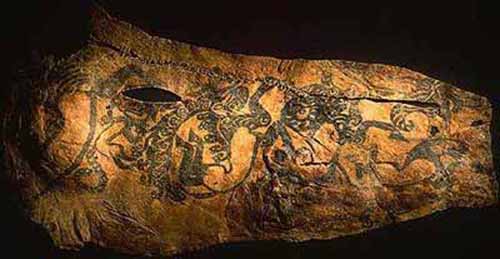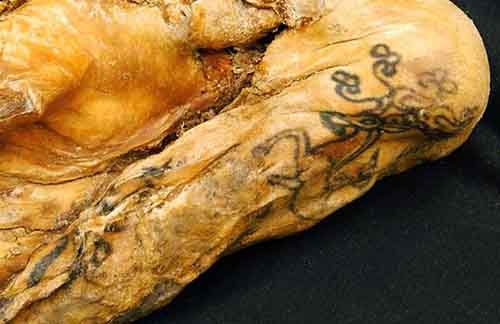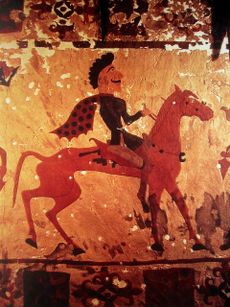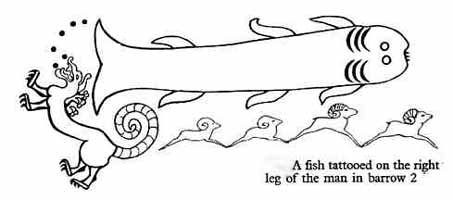The Pazyryks
China: Tarim Basin (West China, Xinjiang) revealed several tattooed mummies of a Western (Western Asian/European) physical type. Still relatively unknown - the Tarim Mummies could date from the end of the 2nd millennium BCE.
The world's most spectacular tattooed mummy was discovered by Russian anthropologist Sergei Ivanovich Rudenko in 1948 during the excavation of a group of Pazyryk tombs about 120 miles north of the border between China and Russia.


These mummies were found in the High Altai Mountains of western and southern Siberia and date from around 2400 years ago. The tattoos on their bodies represent a variety of animals. The griffins and monsters are thought to have a magical significance but some elements are believed to be purely decorative. Altogether the tattoos are believed to reflect the status of the individual.
Three tattooed mummies (c. 300 BCE) were extracted from the permafrost
of Altai in the second half of the 20th century (the Man of Payzyrk,
during the 1940s; one female mummy and one male in Ukok plateau, during
the 1990s). Their tattooing involved animal designs carried out in a
curvilinear style.

The Man of Pazyryk was also tattooed with dots that lined up along
the spinal column (lumbar region) and around the right ankle.
The Pazyryks were formidable iron age horsemen and warriors who inhabited the steppes of Eastern Europe and Western Asia from the sixth through the second centuries BC. They left no written records, but Pazyryk artifacts are distinguished by a sophisticated level of artistry and craftsmanship. The Pazyryk tombs discovered by Rudenko were in an almost perfect state of preservation. They contained skeletons and intact bodies of horses and embalmed humans, together with a wealth of artifacts including saddles, riding gear, a carriage, rugs, clothing, jewelry, musical instruments, amulets, tools, and, interestingly, hash pipes, described by Rudenko as "apparatus for inhaling hemp smoke".
Also found in the tombs were fabrics from Persia and China, which the Pazyryks must have obtained on journeys covering thousands of miles. Rudenko's most remarkable discovery was the body of a tattooed Pazyryk chief: a thick-set, powerfully built man who had died when he was about 50. Parts of the body had deteriorated, but much of the tattooing was still clearly visible. The chief was elaborately decorated with an interlocking series of designs representing a variety of fantastic beasts.
The best preserved tattoos were images of a donkey, a mountain ram, two highly stylized deer with long antlers and an imaginary carnivore on the right arm. Two monsters resembling griffins decorate the chest, and on the left arm are three partially obliterated images which seem to represent two deer and a mountain goat.

On the front of the right leg a fish extends from the foot to the knee. A monster crawls over the right foot, and on the inside of the shin is a series of four running rams which touch each other to form a single design. The left leg also bears tattoos, but these designs could not be clearly distinguished. In addition, the chief's back is tattooed with a series of small circles in line with the vertebral column. This tattooing was probably done for therapeutic reasons. Contemporary Siberian tribesmen still practice tattooing of this kind to relieve back pain.
No instruments specifically designed for tattooing were found, but the Pazyryks had extremely fine needles with which they did miniature embroidery, and these were undoubtedly used for tattooing In the summer of 1993 another tattooed Pazyryk mummy was discovered in Siberia's Umok plateau. It had been buried over 2,400 years ago in a casket fashioned from the hollowed-out trunk of a larch tree. On the outside of the casket were stylized images of deer and snow leopards carved in leather. Shortly after burial the grave had apparently been flooded by freezing rain and the entire contents of the burial chamber had remained frozen in permafrost.
The body was that of a young woman whose arms had been tattooed with designs representing mythical creatures like those on the previously discovered Pazyryk mummy. She was clad in a voluminous white silk dress, a long crimson woolen skirt and white felt stockings.
On her head was an elaborate headdress made of hair and felt - the first of its kind ever found intact. Also discovered in the burial chamber were gilded ornaments, dishes, a brush, a pot containing marijuana, and a hand mirror of polished metal on the wooden back of which was a carving of a deer. Six horses wearing elaborate harnesses had been sacrificed and lay on the logs which formed the roof of the burial chamber.
Considering the number of tattooed mummies which have been discovered, it is apparent that tattooing was widely practiced throughout the ancient world and was associated with a high level of artistic endeavor. The imagery of ancient tattooing is in many ways similar to that of modern tattooing.
All of the known Pazyryk tattoos are images of animals. Animals are the most frequent subject matter of tattooing in many cultures and are traditionally associated with magic, totemism, and the desire of the tattooed person to become identified with the spirit of the animal. Tattoos which have survived on mummies suggest that tattooing in prehistoric times had much in common with modern tattooing, and that tattooing the world over has profound and universal psychic origins.




Comments
Post a Comment
leave a message please